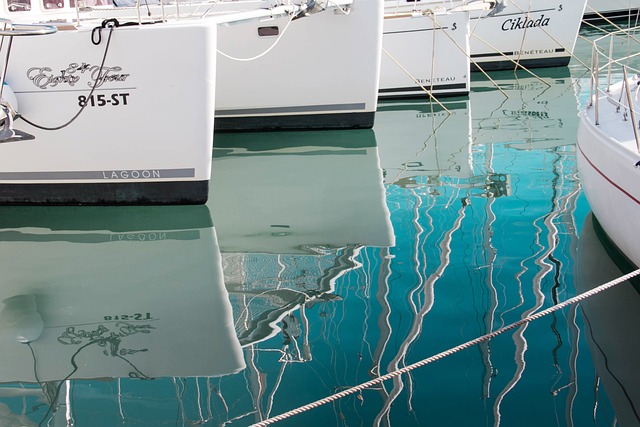Maintaining a marine battery in optimal condition is pivotal for the performance and reliability of your watercraft’s electrical systems. A key aspect of this maintenance involves regularly cleaning the battery terminals to prevent and address corrosion. This article delves into the best practices for assessing, cleaning, and maintaining marine battery terminals. From understanding the role of corrosion to employing effective cleaning techniques, you’ll find a comprehensive guide tailored to ensure your marine battery operates at its best. With the right tools and safety measures in place, you can extend your battery’s lifespan and secure uninterrupted power for all your maritime adventures.
- Assessing the Condition of Your Marine Battery Terminals
- Safety First: Protecting Yourself When Cleaning Marine Battery Terminals
- The Tools and Materials Needed for Effective Terminal Cleaning
- Step-by-Step Guide to Cleaning Marine Battery Terminals
- Understanding the Role of Corrosion and Its Impact on Marine Batteries
- Common Causes of Terminal Corrosion in Marine Batteries
- Techniques for Removing Corrosion from Marine Battery Terminals
- Maintenance Strategies to Prolong the Life of Your Marine Battery Terminals
Assessing the Condition of Your Marine Battery Terminals

Regular maintenance of your marine battery terminals is crucial for optimal performance and longevity of your battery. Over time, corrosion can accumulate on the terminals, which may lead to poor connections and reduced efficiency. To assess the condition of your marine battery terminals, begin by visually inspecting them for any signs of white, powdery corrosion around the posts and clamps. This corrosion is a common issue that can disrupt the electrical connection between the battery and the equipment it powers. If you notice this buildup, it’s advisable to clean the terminals promptly to prevent further issues.
To effectively evaluate the state of your marine battery terminals, use a multimeter to check the voltage across the battery posts. This will help you determine if the battery is holding a charge properly. A multimeter can also be used to measure the resistance of the connections; higher resistance indicates a less conductive connection, which could compromise the performance of your marine battery and your electronics. If you’re not familiar with using a multimeter, consult the user manual or a professional for guidance. Ensuring that your terminals are clean, tight, and corrosion-free will enhance the reliability of your marine battery and contribute to a safer and more enjoyable experience on the water.
Safety First: Protecting Yourself When Cleaning Marine Battery Terminals

When attending to the maintenance of your marine battery, safety should be your top priority during the cleaning process of its terminals. Begin by disconnecting the battery from any electrical circuits to prevent the risk of electric shock. It’s crucial to wear appropriate personal protective equipment (PPE), including insulated gloves and safety glasses, to shield your hands and eyes from any potential corrosive substances or sparks that might arise. Ensure the work area is well-ventilated when using cleaning agents, as fumes can be hazardous.
Before cleaning, inspect the terminals for any signs of excessive corrosion, damage, or swelling, which could indicate improper charging or overcharging and may necessitate further attention from a professional. To clean the terminals, use a wire brush to gently remove any accumulated corrosion, taking care not to damage the terminal or the cable sheathing. After brushing, the terminals should be cleaned with a marine battery cleaning solution applied to a soft cloth or an old toothbrush. Apply the cleaning solution as per the manufacturer’s instructions, ensuring it doesn’t come into contact with your skin or eyes. Once cleaned, dry the terminals thoroughly with a clean, dry cloth to prevent any conductivity issues. Always adhere to the safety guidelines provided in your marine battery’s user manual and prioritize a well-ventilated environment when using cleaning solutions to maintain a safe working atmosphere.
The Tools and Materials Needed for Effective Terminal Cleaning

When maintaining a marine battery, ensuring the terminals are clean and free from corrosion is crucial for optimal performance. To effectively clean marine battery terminals, you will need a set of tools and materials specifically designed for this task. Begin by gathering a wire brush that’s not too abrasive to avoid damaging the battery terminals, a mixture of baking soda and water to form a paste for gentle cleaning, a soft cloth or sponge to wipe away residue, distilled water to rinse the area, and a pair of insulated pliers or a multimeter to ensure safety when handling the battery.
For more thorough cleaning, you may also require a voltage detector to confirm that the battery is indeed discharged before proceeding, and a mask or respirator to protect yourself from any fumes or particles released during the cleaning process. Additionally, have on hand a solution of one part hydrogen peroxide and one part water for an effective and environmentally friendly corrosion remover. Once you have all these materials prepared, you can proceed with confidence, knowing that you have the necessary tools to clean your marine battery terminals safely and effectively, thereby maintaining the reliability of your vessel’s electrical systems.
Step-by-Step Guide to Cleaning Marine Battery Terminals

When maintaining a marine battery, keeping the terminals clean is crucial for optimal performance and longevity. A buildup of corrosion on the terminals can lead to poor connections, reduced efficiency, and even complete failure of the battery. Here’s a step-by-step guide to effectively clean your marine battery terminals:
Begin by safely removing the cables connected to the battery terminals. Ensure that the battery is fully discharged to prevent any risk of electrical shock. Once the cables are off, use a wire brush attached to a drill or an abrasive pad to gently scrub away any corrosion from the posts and connections. Be careful not to damage the terminal surface or surrounding components. After removing the corrosion, wipe the area with a clean, damp cloth to remove any residual grime and loosened corrosion.
Next, prepare a baking soda paste by mixing baking soda with water until you achieve a spreadable consistency. Apply this paste to the terminals using an old toothbrush or a soft brush. The baking soda will act as a mild abrasive and also have a cleansing effect due to its chemical properties. Allow the paste to sit on the terminals for about 15 minutes to loosen any remaining corrosion. After this waiting period, use the toothbrush or brush to scrub the terminals again, focusing on any stubborn areas of corrosion. Once you’re satisfied with the cleaning, rinse the terminals thoroughly with water to remove all traces of the baking soda paste and any loosened debris. Finally, dry the terminals with a clean, lint-free cloth. After reattaching the cables, inspect the battery connections regularly to maintain their integrity and ensure your marine battery operates at peak performance. Regular maintenance of your marine battery terminals can prevent many common issues that affect marine batteries, thereby extending their lifespan and reliability.
Understanding the Role of Corrosion and Its Impact on Marine Batteries

Marine batteries are subject to a unique set of conditions that can lead to corrosion at their terminals, which is not just an aesthetic issue but a functional one as well. Corrosion on battery terminals, often referred to as oxidation, occurs when the metal parts of the terminal (usually lead and alloyed metals) react with substances such as saltwater, oxygen, or electrolyte residues. This reaction forms a corrosion product layer that can prevent optimal electrical connections. Over time, if left unchecked, this layer can grow thick enough to cause a poor connection, leading to reduced battery performance and potential failure to start the engine when needed. In extreme cases, significant corrosion can even cause a short circuit.
Understanding the role of corrosion is crucial for maintaining the longevity and reliability of marine batteries. Corrosion not only affects the connections but also the battery’s internal cells over time. It’s important to regularly inspect the terminals on your marine battery, looking for signs of corrosion such as a white or greenish buildup. The presence of corrosion can disrupt the chemical reactions that are essential for the battery’s operation, leading to a decline in its capacity to hold and deliver power. Therefore, maintaining clean and well-connected terminals is not just about preventing a breakdown; it’s about ensuring your marine battery operates at peak efficiency. Regular cleaning of the terminals with appropriate solutions, like baking soda and water, followed by a thorough rinsing and application of anti-corrosion spray or petroleum jelly as a protective barrier, can mitigate this issue effectively.
Common Causes of Terminal Corrosion in Marine Batteries

Marine batteries are subject to a unique set of conditions that can lead to terminal corrosion, which is often caused by saltwater and the electrolysis process during normal operation. Saltwater exposure is a primary culprit; it accelerates the corrosion of battery terminals due to its reactive nature. When seawater evaporates on the terminal surfaces, it leaves behind a corrosive salt residue. This residue can react with the metal components of the terminals and surrounding connectors, forming a layer of corrosion that can disrupt electrical connections, leading to poor performance or even complete failure of the battery.
Another common cause of terminal corrosion in marine batteries is the electrolysis reaction itself. During charging and discharging cycles, lead oxide from the battery plates can migrate to the terminals, reacting with moisture in the air or any residual water to form additional layers of corrosion. This process can be exacerbated by poor ventilation around the battery, which allows for higher humidity levels and accelerates the chemical reactions. Additionally, the presence of contaminants such as dirt, grease, or even the battery’s own sulfuric acid can contribute to the corrosion process, further complicating the maintenance of reliable connections in marine batteries. Regular cleaning and inspection are essential to mitigate these issues and ensure the longevity and reliability of your marine battery.
Techniques for Removing Corrosion from Marine Battery Terminals

Maintenance Strategies to Prolong the Life of Your Marine Battery Terminals

Regular maintenance of your marine battery terminals is paramount for optimal performance and longevity. To prolong the life of your marine battery, it’s essential to perform routine checks and cleaning. Begin by inspecting the battery terminals for any signs of corrosion or looseness. Corrosion can hinder electrical connectivity, leading to reduced battery efficiency or even failure. Use a wire brush to gently remove any accumulated corrosion from the terminals and the battery posts. Be careful not to damage the terminal or the battery case during this process.
After cleaning, apply a dielectric grease or anticorrosion compound to the terminals to protect them from future corrosion. This protective layer will act as a barrier against moisture and salt, common culprits in marine environments that can degrade terminal connections over time. Additionally, ensure that the battery is securely mounted to prevent movement that can loosen terminals and affect connectivity. Regularly check and tighten any connections using a torque wrench to the manufacturer’s recommended specification to maintain a solid electrical link. By implementing these maintenance strategies, you can significantly extend the life of your marine battery terminals and ensure they operate reliably during all your aquatic adventures.
